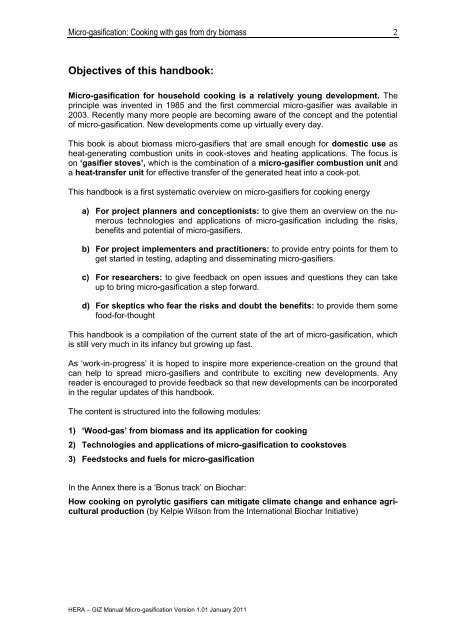Micro-gasification: Cooking with gas from biomass - Amper
Micro-gasification: Cooking with gas from biomass - Amper
Micro-gasification: Cooking with gas from biomass - Amper
You also want an ePaper? Increase the reach of your titles
YUMPU automatically turns print PDFs into web optimized ePapers that Google loves.
<strong>Micro</strong>-<strong><strong>gas</strong>ification</strong>: <strong>Cooking</strong> <strong>with</strong> <strong>gas</strong> <strong>from</strong> dry <strong>biomass</strong><br />
Objectives of this handbook:<br />
<strong>Micro</strong>-<strong><strong>gas</strong>ification</strong> for household cooking is a relatively young development. The<br />
principle was invented in 1985 and the first commercial micro-<strong>gas</strong>ifier was available in<br />
2003. Recently many more people are becoming aware of the concept and the potential<br />
of micro-<strong><strong>gas</strong>ification</strong>. New developments come up virtually every day.<br />
This book is about <strong>biomass</strong> micro-<strong>gas</strong>ifiers that are small enough for domestic use as<br />
heat-generating combustion units in cook-stoves and heating applications. The focus is<br />
on „<strong>gas</strong>ifier stoves‟, which is the combination of a micro-<strong>gas</strong>ifier combustion unit and<br />
a heat-transfer unit for effective transfer of the generated heat into a cook-pot.<br />
This handbook is a first systematic overview on micro-<strong>gas</strong>ifiers for cooking energy<br />
a) For project planners and conceptionists: to give them an overview on the numerous<br />
technologies and applications of micro-<strong><strong>gas</strong>ification</strong> including the risks,<br />
benefits and potential of micro-<strong>gas</strong>ifiers.<br />
b) For project implementers and practitioners: to provide entry points for them to<br />
get started in testing, adapting and disseminating micro-<strong>gas</strong>ifiers.<br />
c) For researchers: to give feedback on open issues and questions they can take<br />
up to bring micro-<strong><strong>gas</strong>ification</strong> a step forward.<br />
d) For skeptics who fear the risks and doubt the benefits: to provide them some<br />
food-for-thought<br />
This handbook is a compilation of the current state of the art of micro-<strong><strong>gas</strong>ification</strong>, which<br />
is still very much in its infancy but growing up fast.<br />
As ‗work-in-progress‘ it is hoped to inspire more experience-creation on the ground that<br />
can help to spread micro-<strong>gas</strong>ifiers and contribute to exciting new developments. Any<br />
reader is encouraged to provide feedback so that new developments can be incorporated<br />
in the regular updates of this handbook.<br />
The content is structured into the following modules:<br />
1) „Wood-<strong>gas</strong>‟ <strong>from</strong> <strong>biomass</strong> and its application for cooking<br />
2) Technologies and applications of micro-<strong><strong>gas</strong>ification</strong> to cookstoves<br />
3) Feedstocks and fuels for micro-<strong><strong>gas</strong>ification</strong><br />
In the Annex there is a ‗Bonus track‘ on Biochar:<br />
How cooking on pyrolytic <strong>gas</strong>ifiers can mitigate climate change and enhance agricultural<br />
production (by Kelpie Wilson <strong>from</strong> the International Biochar Initiative)<br />
HERA – GIZ Manual <strong>Micro</strong>-<strong><strong>gas</strong>ification</strong> Version 1.01 January 2011<br />
2
















